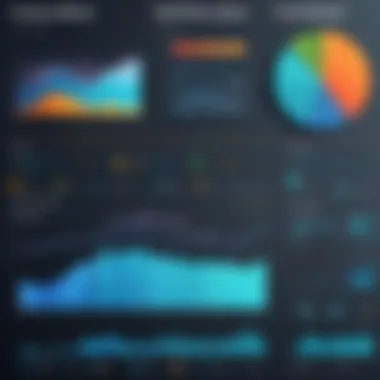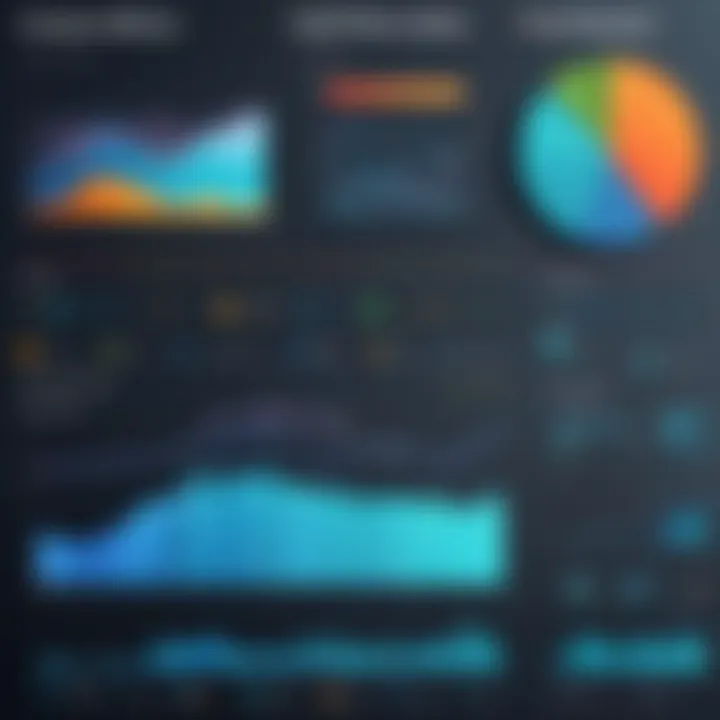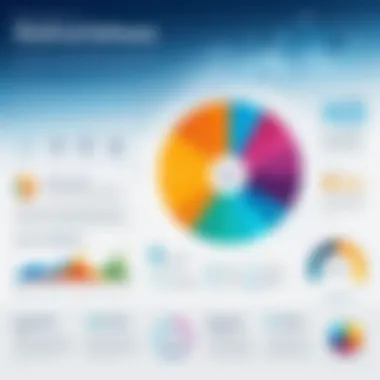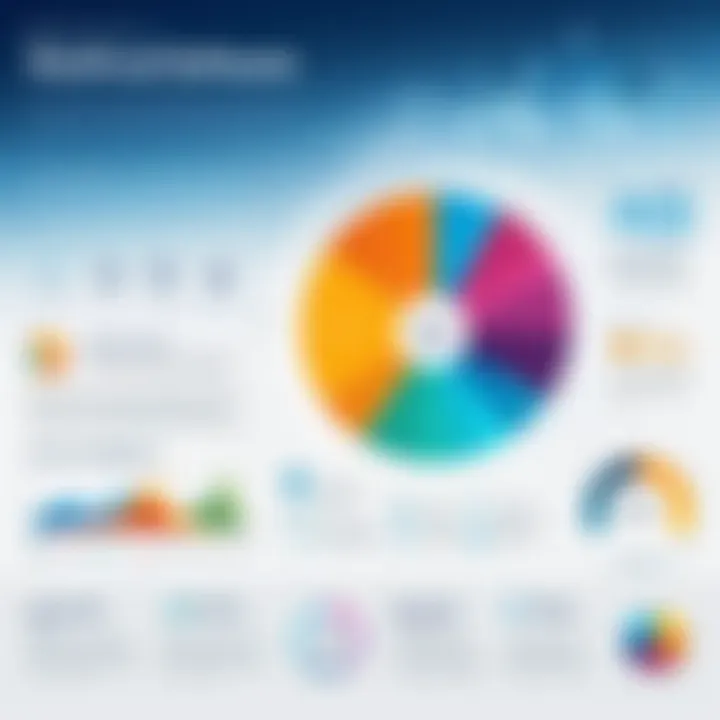Top Statistical Tools for Effective Data Analysis


Intro
In today’s data-driven world, statistical tools play a crucial role in helping organizations make informed decisions. Many industries rely on these tools to analyze vast amounts of data efficiently. With a plethora of options available, choosing the right statistical software can be vital for maximizing the utility of analytical processes. This section highlights the key aspects of various statistical tools, focusing on their functionalities, integration capabilities, pros, and cons.
Understanding statistical software is essential for professionals engaged in decision-making, IT management, and procurement. As data becomes richer and more complex, the tools designed to analyze it must also evolve. This article aims to dissect some of the most effective options on the market, equipping readers with the knowledge to select the best software suited to their specific needs.
Prologue to Statistical Tools
Statistical tools play a pivotal role in the realm of data analysis. They offer a means to distill complex datasets into understandable insights. Understanding these tools is essential for anyone involved in decision-making processes. Businesses rely on statistical analysis to interpret data, identify trends, and enhance operational efficiency. Without statistical tools, a business lacks the ability to analyze its data effectively, leading to uninformed decisions.
Statistical tools range from basic descriptive functions to complex inferential techniques. They help in making sense of large volumes of data, ensuring that insights drawn from data are both accurate and actionable. As we explore different types of statistical tools, it becomes clear how crucial they are in modern business practices and research.
Defining Statistical Analysis
Statistical analysis involves applying statistical methods to data for uncovering patterns and relationships. It starts with data collection, continues through data cleaning, and culminates in the interpretation of results. The purpose of statistical analysis is to provide a framework that facilitates conclusions drawn from data.
There are two main types of statistical analysis: descriptive and inferential. Descriptive statistics summarize data, allowing for quick insights. Inferential statistics, on the other hand, help to make predictions or generalizations about a population based on a sample. Choosing the right type of analysis depends on the specific questions a business seeks to answer.
Importance of Statistical Tools in Business
The importance of statistical tools in business cannot be overstated. These instruments provide a competitive edge. They help in market research, financial forecasting, and quality control, among other applications. Businesses that leverage statistical analysis can uncover hidden patterns in customer behavior, optimize processes, and ultimately enhance profitability.
"Statistical tools are key enablers of data-driven decision-making in today's business environment."
Employers often seek individuals skilled in these statistical methods. The demand for professionals proficient in tools such as R, Python, and SAS reveals a growing recognition of data analytics' significance. Furthermore, businesses must ensure that the chosen statistical tools align with their objectives, resources, and data types. This alignment maximizes the benefits derived from data analysis.
Types of Statistical Tools Available
Understanding the variety of statistical tools is crucial for effective data analysis. Each type serves a distinct purpose and is suited to specific tasks. Proper use of these tools can lead to better insights and informed decisions, which are vital for any organization.
Descriptive Statistical Tools
Descriptive statistical tools summarize and present data in a meaningful way. They transform complex datasets into understandable formats by providing clear insights. These tools help in identifying patterns, trends, and basic characteristics of the data.
Key Features of Descriptive Tools:
- Measures of Central Tendency: These include mean, median, and mode, which provide a sense of average values within the dataset.
- Measures of Dispersion: Range, variance, and standard deviation help understand the spread and variability of the data.
- Visualization Tools: Charts, graphs, and tables visually represent data, making trends easier to comprehend.
Descriptive analysis is often the first step in data analysis. It establishes a foundation for further investigation, highlighting areas that require deeper exploration.
Inferential Statistical Tools
Inferential statistical tools allow analysts to make predictions or inferences about a larger population based on sample data. This is crucial when obtaining data from the entire population is impractical or impossible.
Important Elements for Inferential Analysis:
- Hypothesis Testing: Statistical methods used to determine if there are significant effects or differences between groups.
- Confidence Intervals: These provide a range within which we can expect a population parameter to lie, enhancing the reliability of conclusions drawn from sample data.
- Regression Analysis: This helps in understanding relationships between variables, allowing for prediction of one variable based on another.
The power of inferential tools lies in their ability to generalize findings beyond the sample. This can inform strategic decisions across various fields like marketing, healthcare, and economics.
Predictive Statistical Tools
Predictive statistical tools involve techniques that use historical data to make predictions about future events. They are increasingly popular in business, as organizations seek to anticipate trends and market behaviors.
Characteristics of Predictive Tools:
- Machine Learning Algorithms: These include decision trees and neural networks, which learn from data and improve predictions as more data becomes available.
- Time Series Analysis: This method analyzes data points collected over time to identify trends, seasonal patterns, or cycles.
- Data Mining: Involves exploring large datasets to extract useful information or patterns relevant to predictions.
Predictive tools are instrumental in sectors like finance, retail, and healthcare, where foreseeing future trends can lead to successful strategic planning.
Understanding these three main types—descriptive, inferential, and predictive statistical tools—equips organizations with the capabilities necessary to analyze data effectively. Each type plays a unique role in the overall data analysis process, contributing to more robust decision-making.
Top Statistical Tools for Data Analysis
Statistical tools play a pivotal role in data analysis. They assist in transforming raw data into actionable insights. Choosing the right tool can significantly impact the quality of analysis and subsequent decision-making processes. This section discusses various tools designed for different analytical tasks, leading to more informed strategic choices in business environments.
R Programming Language
Overview of R


R is a programming language primarily used for statistical computing and graphics. It is free and open-source, which adds to its appeal among statisticians and data analysts. R's vast ecosystem of packages allows for specialized statistical techniques that other tools may lack. Its unique feature is robust visualization capabilities, enabling users to create complex graphs and charts easily.
Key Features
R offers many critical features, including advanced statistical methods, built-in data handling, and the ability to perform simulations. These characteristics make it widely used in academia and industry. One unique aspect of R is the community-driven package development, which ensures continuous enhancements and updates. However, the steep learning curve can be a disadvantage for beginners.
Use Cases
R is particularly effective in areas like bioinformatics, finance, and social science research. Its flexibility and power make it suitable for tasks ranging from basic data manipulation to advanced machine learning algorithms. While it excels in academic settings, some businesses may find it less approachable than more user-friendly options.
Python with Pandas and NumPy
Preamble to Python
Python is a versatile programming language known for its simplicity and readability. It is compelling for data analysis because it allows analysts to work efficiently with data. Its clean syntax means that users can focus more on solving problems rather than struggling with complex programming concepts. Python is open-source, thereby available to a wide audience.
Libraries Overview
Two crucial libraries for data analysis in Python are Pandas and NumPy. Pandas enables data manipulation and analysis with its data structures, such as DataFrames. NumPy, on the other hand, offers support for arrays and matrix operations. Together, they facilitate a wide range of analytical tasks efficiently. The primary advantage is the integration of these libraries, providing a holistic framework for data handling.
Applications in Data Analysis
Python is utilized in numerous domains such as finance, web analytics, and scientific computing. With libraries like Matplotlib for visualization, Python covers nearly all aspects of data analysis. Its adaptability is a key reason for its popularity; however, users must be mindful of potential performance issues with very large datasets compared to other specialized tools.
SAS (Statistical Analysis System)
Overview of SAS
SAS is a software suite used for advanced analytics, business intelligence, and data management. It has established itself as a standard among organizations requiring detailed predictive analytics. One primary feature of SAS is its strong focus on data integrity and security, which is crucial in regulated industries like healthcare. However, SAS can be costly compared to open-source alternatives.
Core Features
The core capabilities of SAS include a rich set of statistical tools, data analytics, and reporting features. Users also benefit from a user-friendly interface, which can enhance productivity. Unique to SAS is its integrated approach for data management, allowing users to clean and prepare data alongside analytical tasks. Despite its advantages, a notable limitation is the high licensing fees that may deter smaller organizations.
Target Users
SAS is preferred in large enterprises, particularly in sectors like finance, pharma, and government. Its comprehensive training modules and support structures make it a solid choice for organizations that require consistent results. However, smaller businesses may find its subscription fees challenging.
SPSS (Statistical Package for the Social Sciences)
Overview of SPSS
SPSS is a comprehensive software package used for statistical analysis in social science research. It offers a wide range of statistical tests and procedures, with a user-friendly interface that appeals to both beginners and experienced analysts. A key characteristic of SPSS is its strong emphasis on descriptive statistics and inferential techniques. However, SPSS can be less flexible than programming-based solutions.
Technical Features
SPSS includes features like data management, statistical testing, and model building. Its user-friendly design allows for easy operation through menus rather than code. Unique to SPSS is the output viewer, which helps users organize results and graphs effectively. While convenient, the lack of advanced programming capabilities could limit more sophisticated analyses.
Common Applications
SPSS is widely used in academia and various industries for survey data analysis, market research, and quality control studies. Its rich feature set supports a diverse array of statistical methods. However, the licensing cost may make it less appealing for casual or small-scale users.
MATLAB
Prologue to MATLAB
MATLAB is a programming platform designed for engineers and scientists. Its primary use is in matrix computation, data visualization, and algorithm development. MATLAB stands out for its ease of use when working with matrices and its powerful plotting capabilities. This language is beneficial for users interested in performing simulations or modeling complex datasets.
Advantages for Data Analysis
MATLAB's key advantage lies in its ability to handle complex mathematical computations efficiently. Users can leverage built-in functions for statistical analysis and visualization. A unique feature is the toolbox architecture, which allows the addition of various toolboxes for specialized analysis, such as statistics or machine learning. However, its cost can be prohibitive for some users.
Expert User Scenarios
MATLAB is often used in engineering, finance, and research settings where intricate modeling is needed. Its capabilities are suitable for advanced users who require detailed visualizations and complex mathematical computations, but casual users may find its functionalities overwhelming.
Tableau
Data Visualization Capabilities
Tableau is a powerful data visualization tool that helps users interpret data through accessible visual formats. Its primary strength is transforming complex datasets into interactive dashboards and graphs. Tableau is often recognized for its drag-and-drop functionality, which allows users without extensive technical skills to create visualizations easily. However, it is not primarily an analytical tool, and users may need complementing software for in-depth statistical analysis.


Tools Overview
Tableau includes features for real-time data analysis, allowing users to work with live data sources. Another aspect is the collaboration features, designed for sharing insights across teams easily. Its unique capability is the integration with multiple data sources, which enhances its flexibility. Nonetheless, the high cost of licensing may deter smaller businesses.
User Experiences
Many users appreciate Tableau for its user-friendly interface and the ability to create visually stunning reports. However, the learning curve for more advanced features can be steep. Users may also find that, without additional tools, it lacks in-depth statistical analysis capabilities.
Excel as a Statistical Tool
Capabilities in Statistical Analysis
Excel is not only a spreadsheet tool but also a powerful statistical analysis software. It provides essential functionalities such as regression analysis, hypothesis testing, and descriptive statistics. One key characteristic of Excel is its accessibility; nearly everyone in business is familiar with its interface. However, while it is suitable for basic analyses, it lacks the depth of more specialized tools.
Advantages and Limitations
Excel's primary advantage is its integration into daily business tasks, which means it is readily available for analysis. But, its limitations include performance issues when handling very large datasets and a lack of advanced statistical functions available in other software. Users must be cognizant of these shortcomings when deciding on their analytical needs.
Best Practices
To maximize Excel's effectiveness, it is important to follow best practices like maintaining clear data structures, using templates for common analyses, and regularly updating formulas. Adhering to these practices can help avoid common pitfalls in data analysis. Nevertheless, for advanced analyses, consider complementing Excel with more specialized statistical tools.
Comparative Analysis of Statistical Tools
In the realm of data analysis, selecting the right statistical tool can profoundly impact decision-making and overall efficiency. The comparative analysis of statistical tools serves as a vital element in this article, providing insights into various software choices available for data professionals. By scrutinizing different statistical tools, readers gain clarity on their strengths and weaknesses, allowing for informed decision-making based on specific needs.
A thorough comparative analysis is essential because it empowers businesses to align their analytical processes with their operational goals. This section will delve into a few key areas that are critical when comparing these tools:
Cost Considerations
The financial implications of acquiring statistical tools cannot be ignored. Different tools come with disparate pricing models, which can be subscription-based, one-time purchases, or even open-source options.
- Open-source tools like R and Python are typically free, which can be extremely advantageous for startups or those on tight budgets.
- Commercial tools such as SAS and SPSS often require significant upfront investment, including licensing fees.
- Beyond initial costs, ongoing expenses for training, support, and upgrades should be evaluated. Organizations should weigh the total cost of ownership against the potential return on investment that each tool offers.
Understanding the cost landscape not only helps in budgeting but also in assessing which tools provide the best value for specific business needs.
Ease of Use
The user-friendliness of a statistical tool plays an important role in its adoption within an organization. A steep learning curve may hinder utilization, even if a tool is sophisticated in its capabilities.
When considering ease of use, factors to evaluate include:
- User Interface: Intuitive interfaces can significantly enhance the learning experience for new users. Tools with user-friendly designs often lead to quicker mastery.
- Documentation and Support: Comprehensive guides and community forums can assist users in overcoming challenges during initial setup or advanced analyses.
- Training Resources: Availability of training programs can improve how quickly employees can adapt to new software, thus maximizing productivity from the get-go.
Ultimately, tools that are easier to learn and use can lead to more effective data analysis and, therefore, more informed decision-making.
Integration with Other Tools
In today’s interconnected digital ecosystem, the ability of a statistical tool to integrate seamlessly with other software is crucial. Integration capability can enhance the functionality of standalone tools and enable more complex data workflows.
Some key points regarding integration include:
- API Access: Tools that provide robust Application Programming Interfaces (APIs) allow for smoother interactions with other software solutions, which can automate data transfers and streamline workflows.
- Compatibility with Databases: A good statistical tool ought to interface well with popular databases like SQL and NoSQL, facilitating the import and export of data effortlessly.
- Collaboration with Visualization Tools: For extensive data reporting, statistical tools that integrate with visualization software like Tableau or Power BI can present data findings more effectively.
The capacity for a statistical tool to work harmoniously with other applications can significantly enhance an organization’s analytical capabilities.
Highlights: A comparative analysis of statistical tools illuminates not just the features but also essential aspects like costs, usability, and integration. This scrutiny guides organizations in making decisions that align with their analytical goals.
Data Preparation and Cleaning Tools
Data preparation and cleaning are crucial steps in the data analysis process. Without clean data, the accuracy of analysis diminishes. Poor quality data can lead to misleading conclusions and decisions. In business settings, the impact of data quality extends to all levels of operation. Hence, investing resources in effective data preparation is essential for anyone serious about data-driven decision-making.
The Role of Data Cleaning
Data cleaning serves as the foundation of any robust data analysis framework. This process involves identifying and correcting inaccuracies, removing duplicates, and addressing missing values. Clean data leads to reliable outcomes. Organizations can trust the insights drawn from their data when the information is precise and consistent. Data cleaning not only enhances the quality of analysis but also improves the overall efficiency of data processing.
Overall, data cleaning reduces noise which can skew results. This ensures that analyses reflect true patterns and trends. Moreover, a well-prepared dataset often accelerates the data analysis procedure, freeing up valuable time for analytical tasks.
Common Data Cleaning Techniques


There are several widely used data cleaning techniques that professionals must be familiar with:
- Removing Duplicates: Identifying and eliminating duplicate records helps maintain data integrity.
- Handling Missing Values: Missing data can skew results. Techniques like mean imputation or using predictive models fill in these gaps without distorting overall data validity.
- Normalizing Data: Standardizing data formats ensures that similar entries are easily comparable. This is especially crucial for categorical data with varying terminologies.
- Filtering Outliers: Detecting and assessing outliers can prevent distorted findings. It’s essential to decide whether to exclude these values based on business relevance and analytical goals.
- Data Type Conversion: Ensuring that data types are appropriate for analysis improves the applicability of analytical methods. For instance, ensuring that date entries are not treated as strings is necessary for time-series analysis.
- Validation Checks: Regularly applying validation rules can identify errors early, preventing incorrect data from entering analysis pipelines.
Each of these techniques plays a vital role in ensuring that the data used for analysis is accurate and meaningful. Proper implementation of these practices can significantly strengthen the outcomes of any data-driven investigation.
Statistical Analysis Techniques
Statistical analysis techniques form a backbone of data-driven decision-making. These methodologies help professionals to interpret data efficiently, transforming raw numbers into actionable insights. By employing appropriate techniques, businesses can evaluate scenarios, assess risks, and make informed choices that push the organization towards its goals.
Regression Analysis
Regression analysis is a powerful statistical method used to understand relationships between variables. It allows professionals to assess how the value of one variable (dependent) changes when another variable (independent) is varied. This technique is essential for predicting outcomes and determining trends.
For example, if a company wants to forecast sales based on advertising spending, regression analysis can be employed. The resulting model provides clarity on how much changes in marketing efforts might impact sales. Key considerations include the type of regression used—linear, multiple, or logistic depending on the data context. The ability to analyze these associations translates into advanced forecasting and strategic planning.
Descriptive Statistics
Descriptive statistics summarize and describe the characteristics of a dataset. This technique provides insights into the distribution, central tendency, and variation in data. For instance, using measures such as mean, median, and mode allows professionals to grasp typical values swiftly. In addition, understanding standard deviation and variance helps in recognizing data variability.
Descriptive statistics serve as a solid foundation for further analysis. Raw data, if presented without context, can be overwhelming. However, harnessing concise statistics simplifies the data presentation, making it easier for stakeholders to derive insights at a glance. Therefore, they play a critical role in reports and presentations.
Hypothesis Testing
Hypothesis testing is a systematic approach to making inferences about populations based on sample data. This technique tests assumptions through a set process, defining a null hypothesis and an alternative hypothesis. For example, if a business assumes a new marketing strategy increases sales, hypothesis testing can either validate or disprove this claim by analyzing sample data.
The significance level, often set at 0.05, determines the threshold for rejecting the null hypothesis. Practitioners must be cautious about Type I and Type II errors, as both can lead to incorrect conclusions. Through hypothesis testing, organizations can back their decisions with statistical evidence, paving the way for data-backed strategies.
Understanding these statistical analysis techniques allows professionals to unlock the true potential of their data, resulting in informed decisions that drive business success.
Case Studies of Successful Data Analysis Implementations
The examination of case studies in data analysis showcases the tangible benefits that organizations can achieve through the judicious application of statistical tools. These real-world examples provide insight into how various companies have leveraged data analysis to drive decision-making, streamline operations, and enhance their strategic direction. Understanding these implementations helps other businesses recognize the potential of statistical analysis and adopt similar practices to their advantage.
Organizations that engage in systematic data analysis frequently experience increased efficiency and improved performance. The specificity of each case study allows others to draw parallels and learn from successes and failures alike. Additionally, these instances shed light on how unique challenges can be addressed through data-driven strategies, allowing future implementations to be more effective.
Industry-Specific Examples
In this section, we can look at industry-specific cases to illustrate the diverse applications of statistical tools in real-world scenarios:
- Healthcare Sector: A prominent hospital used data analysis tools to reduce patient wait times. By analyzing patterns in patient flow and staff efficiency, they implemented scheduling adjustments. This led to a 30% reduction in average wait times, significantly enhancing patient satisfaction.
- Retail Industry: A major retail chain utilized predictive analytics to optimize inventory levels. By analyzing past sales data and customer preferences, they reduced overstock situations and learned to manage seasonal demand effectively. This resulted in a 15% increase in sales during peak periods.
- Finance Sector: A financial institution applied regression analysis to assess credit risk. By analyzing historical data and customer behavior, they improved their loan approval process, leading to a 20% decrease in default rates.
These examples demonstrate the potency and adaptability of statistical tools across various sectors, underscoring their ability to deliver valuable insights that influence key business decisions.
Challenges Faced and Overcome
While implementing data analysis strategies can lead to positive outcomes, organizations often face several challenges:
- Data Quality Issues: Many organizations struggle with data accuracy and completeness. For instance, custom software tools may not always provide the cleanest data, necessitating robust cleaning and preparation before analysis begins.
- Resistance to Change: Employees may resist adoption of new analytical tools, especially if they have been using traditional methods for years. For instance, a certain manufacturing firm faced pushback when transitioning from manual data entry processes to automated analytics software. Combating this resistance required adequate training and clear communication about the benefits of new systems.
- Integration with Existing Systems: Harmonizing new statistical tools with existing software can be tricky. In one financial corporation, the integration of a new analytics platform with legacy systems created compatibility issues, resulting in data silos. This situation compelled the company to reassess its technology stack to ensure smoother integration.
Despite these challenges, organizations that successfully navigate them often reap substantial rewards. Effectively addressing potential issues can lead to improved analytical capabilities and more informed decision-making.
In summary, studying successful data analysis implementations across various industries offers vital lessons and practical insights. This understanding not only helps to clear some of the hurdles that may arise but also enhances the overall strategy for deriving value from statistical tools.
End
The significance of this conclusion cannot be understated. It serves as an opportunity to distill the information presented throughout the article, encapsulating the critical aspects of statistical tools for data analysis. Understanding various statistical tools is essential for professionals navigating the complexities of data. These tools not only facilitate the analysis but also empower businesses to make informed decisions.
As we recap key points discussed earlier, readers can appreciate the subtle nuances and diverse applications of each tool. Insight into their unique features promotes better understanding, driving the selection process for the most suitable software tailored to specific needs.
Moreover, the conclusion is a prompt for reflection on the future of statistical analysis within business contexts. The emphasis lies on continuous adaptation to evolving technologies and methodologies. This adaptive approach will be crucial for remaining competitive and responsive to market shifts.
Recap of Key Points
- Statistical tools provide essential support for data analysis in decision-making processes.
- Various categories, including descriptive, inferential, and predictive tools, cater to different analytical needs.
- Prominent tools such as R, Python with Pandas, SAS, SPSS, MATLAB, Tableau, and Excel, each come with distinct features and applications.
- Data preparation and cleaning are as important as analysis, impacting the quality of insights derived from the data.
- The importance of understanding costs, ease of use, and integration with existing systems when selecting a statistical tool cannot be overlooked.
This recap serves to clarify the overall importance of integrating statistical tools into professional practices, enhancing efficiency and data-driven decision-making.
Future Trends in Statistical Tools
The landscape of statistical tools is decidedly dynamic, with several trends emerging that showcase the direction of data analysis. Notably, there is a growing emphasis on artificial intelligence (AI) and machine learning capabilities within statistical software. This integration allows for deeper analysis and faster processing of large datasets.
Cloud-based solutions are becoming increasingly popular, facilitating easier collaboration and access to powerful tools from any location. This shift hints at a future where data analysis is less bound by hardware constraints.
Furthermore, user experience and visualization capabilities are likely to continue evolving. As professionals demand more intuitive interfaces, software developers must cater to these needs, thereby improving productivity.
Finally, as data privacy becomes more crucial, future tools will need to embed robust security features, ensuring that sensitive information remains protected during analysis. This consideration of ethical data use will shape the design and operation of statistical tools moving forward.







